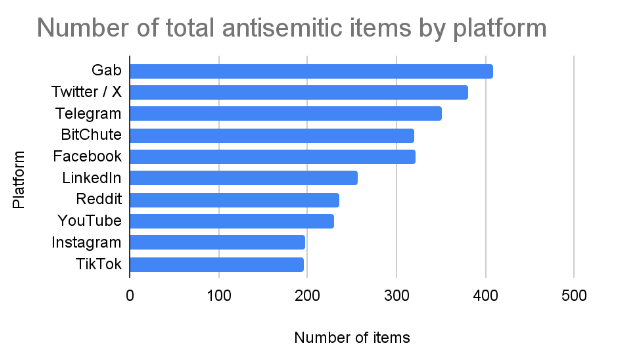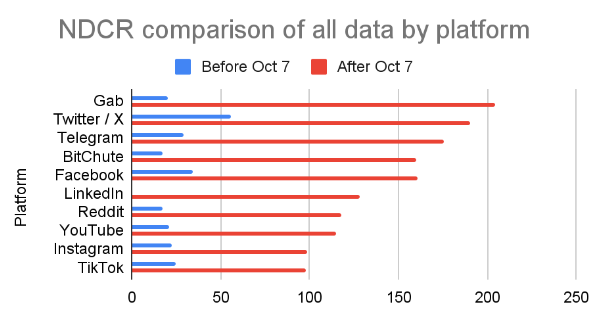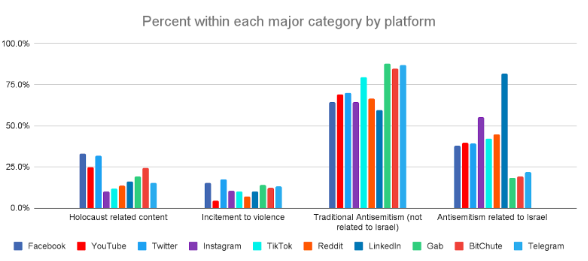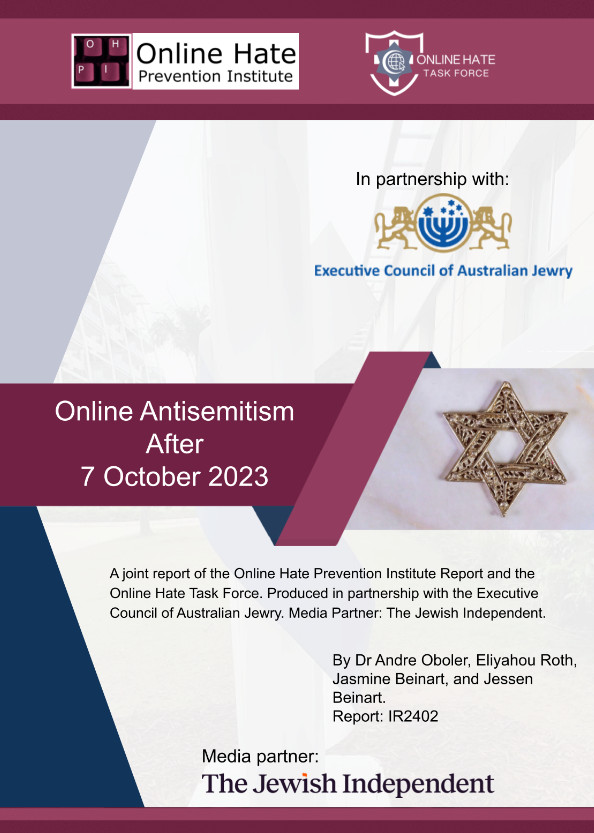Following five months of intensive work the Online Hate Prevention Institute (Australia) and Online Hate Task Force (Belgium) share a groundbreaking new report Online Antisemitism After October 7 2023.
About the report
Antisemitism surged following the Hamas terrorist attack on October 7, 2023. Antisemitism on social media incited offline incidents including hate crimes, reflected the hostile offline environment, and promoted a social acceptability of antisemitism normalised this hostility. This report provides a vital in-depth analysis of online antisemitism in the months after the October 7 attack. It empirically compares the year leading up to the attack with what followed. It provides examples showing the nature of the harm.
The report is based on 160 hours of monitoring by experts, 16 hours on each of 10 platforms: Facebook, Instagram, TikTok, X (Twitter), YouTube, Telegram, LinkedIn, Gab, Reddit, and BitChute. The data has been categorised using 27 subcategories of antisemitism, and summarised into 4 major categories: traditional antisemitism, Israel related antisemitism, problematic Holocaust related content, and incitement to violence. The systematic collection process with the same amount of time spent gathering data for each platform results in a rate of collection and sample size that reflects how prevalent antisemitism was on each platform. This is compared to work using the same methodology over the year leading up to October 7.

In total 2898 items of antisemitism were collected. This represents a 539% increase compared to the year prior to October 7. The increase was not uniform. Antisemitism on the alternative social media platform Gab, favoured by the far-right, grew by a factor of 10, compared to TikTok where antisemitism grew by a factor of 4. The category of incitement to violence grew by a factor of 21, while inappropriate Holocaust related content merely tripled.


The best takedown rate, when a platform removed content based on a report from a user, occurred on Instagram where 55% of Holocaust related content was removed. One of the worst rates was on Telegram where only 3% of traditional antisemitism was removed. LinkedIn has far more antisemitism than expected, but the most consistently high rates in taking content down.
The report shows us how antisemitism changed, and the problems that need to be addressed to recover from this surge in hate against Jews.

Press release
Melbourne, 27 March 2024.
Jewish people are scared. A hostile environment has been created in which targeting Jews seems to once again be acceptable. This environment includes instances of harassment and abuse in the streets, and rising levels of antisemitic hate crimes in countries around the world. Most Jewish people, however, are experiencing it through a constant stream of online hate, the “antisemitism 2.0” that normalises the hatred and targeting of Jews in society.
A new report from the Online Hate Prevention Institute (Australia) and Online Hate Task Force (Belgium) gives the most comprehensive picture yet of online antisemitism in the world after the October 7 Hamas terrorist attack and the resulting war. Drawing on almost 3,000 items of data, each assessed by experts, the research examines antisemitism across ten social media platforms and twenty-seven specific types of antisemitism.
Dr Andre Oboler, CEO of the Online Hate Prevention Institute explained, “This is not a report about criticism of Israeli policies, or Palestinian activism. Each type of antisemitism is both explained and demonstrated with examples. The report also includes examples of the antisemitism on Facebook, Instagram, TikTok, X (formerly Twitter), YouTube, Telegram, LinkedIn, Gab, Reddit, and BitChute. There are over 100 examples of actual online content shown and discussed in this report. People can look and judge for themselves.”
With over eighty graphs the report shows how the prevalence of different types of antisemitism differ across social media platforms. It documents an astronomical rise in cases of “calling for, aiding, or justifying the killing or harming of Jews in the name of a radical ideology or an extremist view of religion” following the October 7 terrorist attack. Worryingly, this narrative supporting violence against Jews can now be seen in one out of every ten antisemitic items online.
It’s not just the justifications for violence, the old staples are back in fashion as well. Seventy-five percent of all the online antisemitism examined involved traditional antisemitism. In fact, forty-five percent of all the antisemitic items involved the specific subcategory of “promoting traditional antisemitism such as blood libel and claims Jews killed Jesus”. Other subcategories of traditional antisemitism included claims of a world Jewish conspiracy, Jewish media control, Jewish control of banks, Jewish control of governments, holding Jews responsible for the acts of individuals, and accusing Jews of being disloyalty to their country.
The largest growth (over 1000%) compared to before October 7 was in antisemitism related to Israel. Within this category, however, the dominant form this took on every platform was using the traditional antisemitism just mentioned, but in relation to Israel or Israelis. Often the only mention of Israel was in the hashtags. This is not criticism of Israeli policy but the promotion of antisemitic hate speech.
On LinkedIn the level of traditional antisemitism used in relation to Israel was matched by an equal number of posts comparing Israeli policy to Nazism, something that distorts understanding of the Holocaust, among its many other problems. This is occurring twice as often on LinkedIn as on the other platform.
The rate at which antisemitism was removed was also examined, and the results are concerning. On a platform basis (across all types of antisemitism) they range from 36% down to 4%. By category, across all platforms, incitement to violence was the most removed form of antisemitism, but only 24% of the reported content was removed. Traditional antisemitism was the least removed category, and only 17% of that was removed.
Diving deeper we see the best takedown rate on Instagram where 55% of inappropriate Holocaust related content was removed. This shows a positive response by Meta to an investigation by the Oversight Board. At the same time, on Facebook only 9% of the Israel related antisemitism came down. Mentioning Israel seems to be granting otherwise blatant antisemitism immunity.
There are many stories buried in the data of this report, from discussions of ChatGPT to generative AI. From complex stories of the Middle East being reduced to online memes, then stickers plastered to public spaces. The most concerning is the discussion on Racist Anti-Zionism a phenomenon that is leading to justifications for antisemitism and efforts to silence any concerns that are raised about antisemitism. It’s already in full swing on our Facebook post where we first shared the new report.
For too many people today, as David Baddiel put it, it seems Jews Don’t Count. As a society, we can’t accept that. Not when the evidence (see https://ohpi.org.au/afteroct7/) is so clearly put in front of us.
Media Coverage
- Deborah Stone, “Exclusive: new study shows five-fold increase in online antisemitism since October 7“, The Jewish Independent, 26 March 2024
- The Jewish Independent, “New Study Shows Five-fold Increase in Online Antisemitism Since October 7”, Haaretz, 26 March 2024
- The Jewish Independent, “New Study Shows Five-fold Increase in Online Antisemitism Since October 7”, MSN, 27 March 2024
- “New report: Online antisemitism has soared since October 7. (But we all knew that.)“, Elder of Ziyon, 27 March 2024
- “A deep-dive into online antisemitism“, J-Wire, 29 March 2024
- Andre Oboler, “Why Meta’s decision on ‘Zionists’ as a proxy for Jews matters – opinion“, Jerusalem Post, 21 July 2024.
- Natalie Whiting, “Online hate analysts are calling for greater eSafety powers after study finds rise in anti-Semitism and Islamophobia“, ABC News (website), 4 August 2024.
- “Online hate analysts are calling for greater eSafety powers“, ABC News (website – video), 4 August 2024.
- “Online hate analysts are calling for greater eSafety powers”, ABC News 24 (TV), Broadcast 4 August 2024.
- ABC News Victoria, TV Broadcast 7pm, 4 August 2024. (Available on iView)
- “Online hate analysts are calling for greater eSafety powers after study finds rise in anti-Semitism and Islamophobia“, MSN, 4 August 2024.
Next steps
- Support our work by making a donation on our donations page
- Join our mailing list to stay updated, see the bottom of this page
- You can also follow us on Facebook, LinkedIn, and X (Twitter)
- Individuals wishing to report antisemitism and contribute to our work can do so via our Fight Against Hate platform. See the reporting section on our Antisemitism page.
We welcome statements of support for this work from those academics, civil society organisations, Jewish community leaders, politicians, and government officials working to tackle antisemitism.
We are also looking to expand our monitoring capacity, working with organisations around the world. Our model for this work is for local organisations to engage a team of volunteers or staff to monitor online antisemitism. The Online Hate Prevention Institute provides training, management, and tools to ensure consistency and quality. Data is shared with participating organisations while also contributing to our global pool of data driving reports like this one. We welcome support from donors to enable this expansion.
